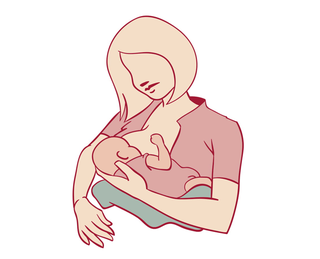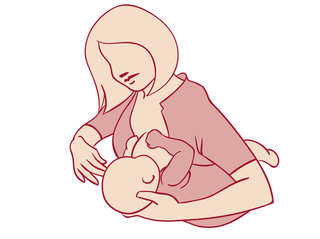As breastfeeding begins you may have trouble with your baby attaching to one side only.
This can be because:
- they prefer to feed on this side
- there may be a physical cause for this behaviour - for example, your baby has a sore head after a difficult birth
This is a common breastfeeding issue. It is often easily resolved with advice and support from a breastfeeding specialist.
If your baby has been feeding well but suddenly latches to only one side, there may be an underlying medical reason. Talk to your GP or public health nurse (PHN).
Ask our breastfeeding experts
Side preference
Sometimes you may be more comfortable feeding on one side in particular. Your baby may also have a preferred side.
This can lead to less stimulation and less milk supply on the less preferred side. Eventually your baby becomes fussy and refuses the less preferred side altogether.
Practical tips
If your baby prefers feeding in a certain position, try moving them over to the other breast. When you do so, keep the same position.
For example, your baby is on the right and breastfeeding well with a cross-cradle position. Move them over to the left, keeping a 'football hold' position.
You can also try starting feeds on the baby’s least favourite side first.
The cross-cradle position

Football hold position

Other things you can try
- Experiment with different positions - for example, the laid-back position can work best for babies with a sore head
- Offer your baby the less preferred side when they are in a light sleep - they will be less aware and less hungry
- Offer your baby the less preferred side while distracting them with walking or rocking
- Give your baby skin-to-skin care before feeding
If none of these work, get advice from a breastfeeding specialist.
Express milk regularly while you try to get them feeding on the less preferred side. This will help to protect your milk supply.
Concerns with your breast milk supply
If one side preference continues
Many families have exclusively breastfed babies on one side. In most cases it is possible to make enough milk. But it depends on the storage capacity of the breast.
A baby who feeds only on one side may need to feed more often than a baby taking both sides. Each breast may be a different size if your baby is feeding only on one side. But when you stop breastfeeding, your breasts will return to about the same size.
Torticollis
Some babies may have torticollis (wry neck). This is where the muscles of the neck are out of alignment. When a baby is born with this condition, it's known as congenital torticollis. It can also develop later.
In rare cases, it can be caused by instrumental delivery when your baby is being born. Forceps or vacuum deliveries can strain the muscles of the neck.
Torticollis can lead to feeding problems such as difficulty attaching to the breast. It can also lead to preferred sides or positions.
Your paediatrician or GP can refer your baby to a physiotherapist. This will help to relieve symptoms.
How to get your baby assessed
Get your baby assessed by an International Board Certified Lactation Consultant (IBCLC). Some public health nurses (PHNs) and GPs are IBCLCs. Ask if they can help.
If your baby is under 6 weeks, the lactation consultant in your maternity unit can review your baby. This will be free of charge. Most units run postnatal breastfeeding clinics. You can asked to be referred.
If your baby is older, your PHN or local breastfeeding support group may be able to help you.
There are also private lactation consultants who may be able to visit you at home. You'll have to pay for this service. But you can get reimbursed if you have private health insurance.